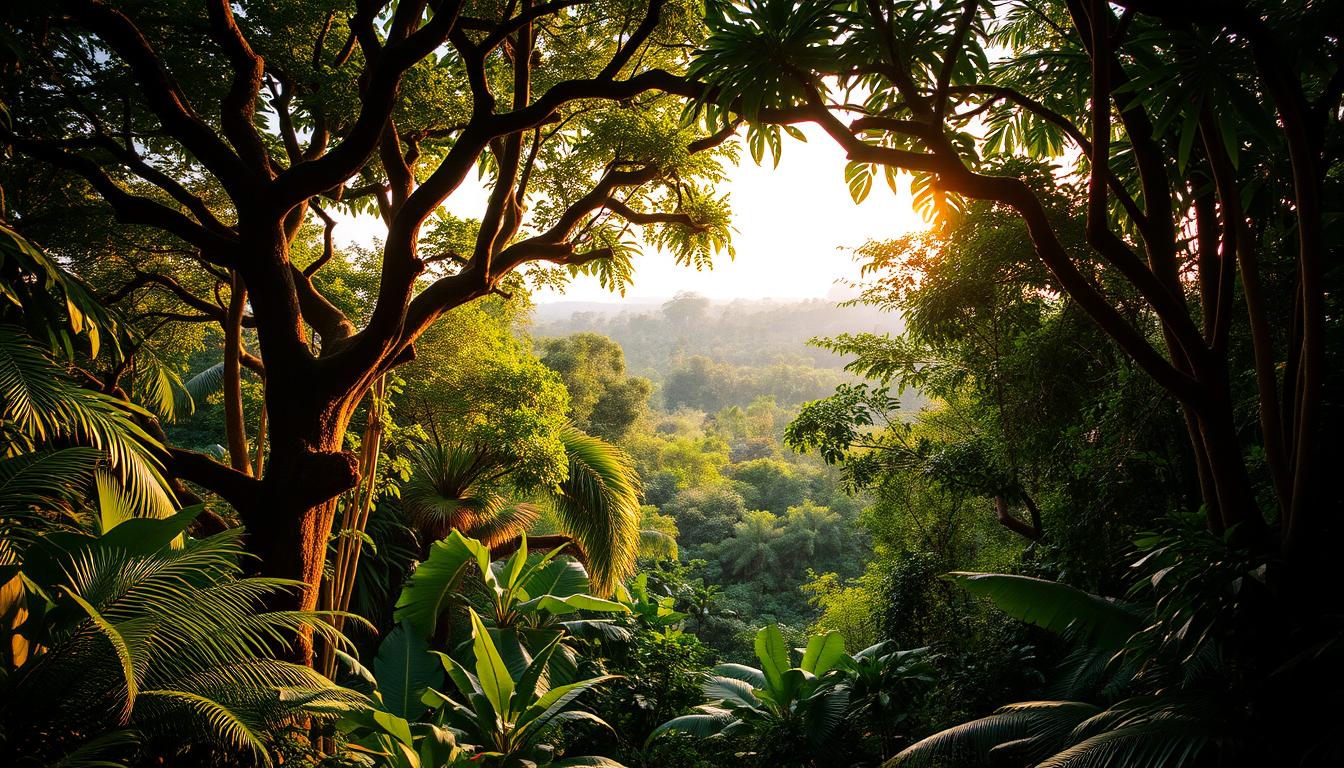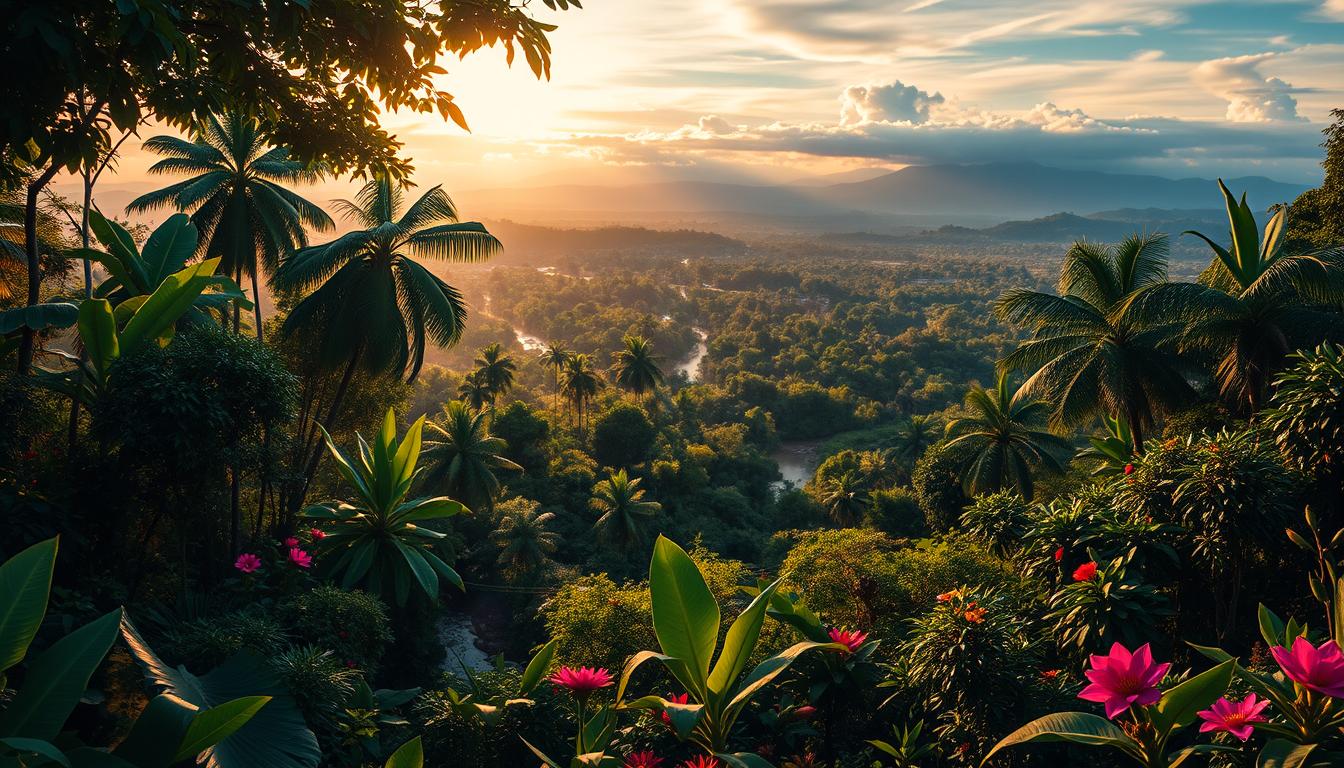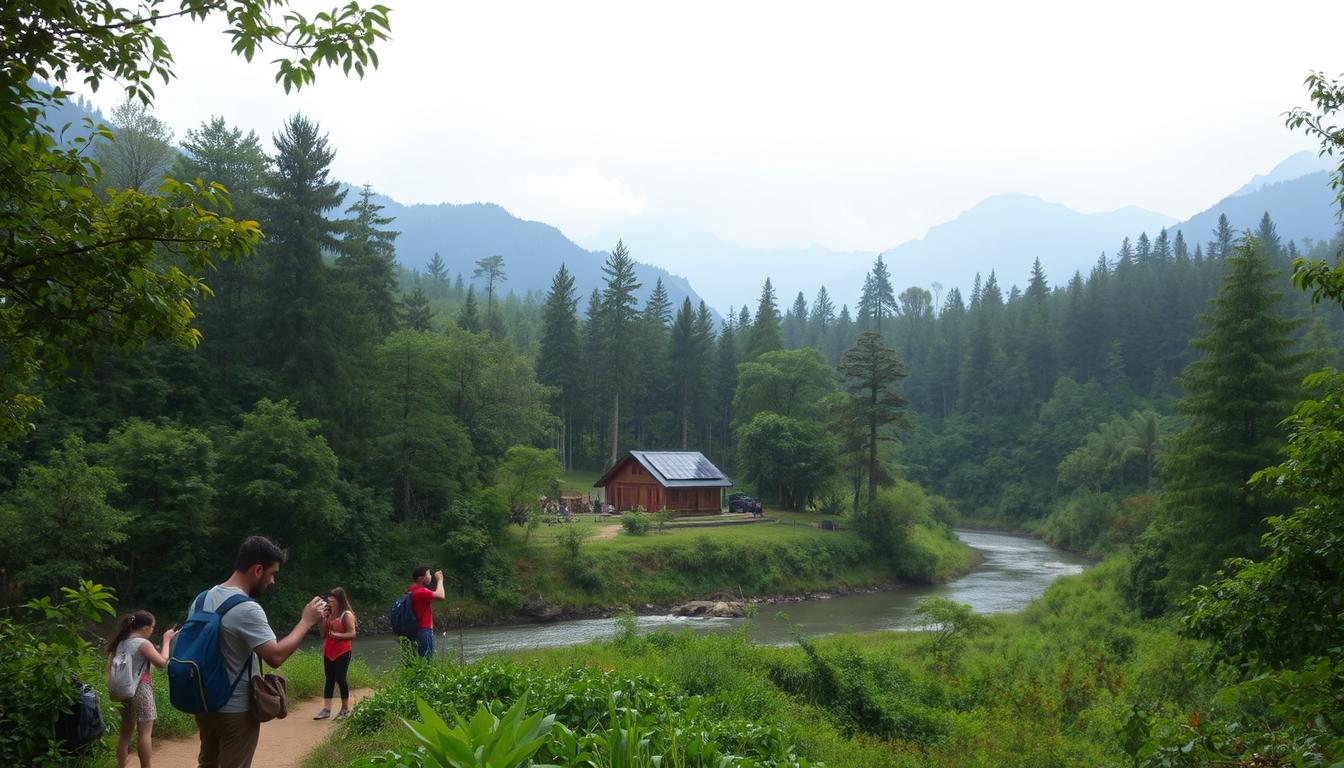The Amazon Jungle, often referred to as the “lungs of the Earth,” is a vast and intricate ecosystem that plays a pivotal role in the global environment. It is not just a treasure trove of biodiversity but also a significant contributor to the world’s economy.
This region’s economic content is vast, ranging from timber and minerals to tourism and pharmaceuticals derived from its rich biodiversity. The synergy between the jungle’s ecosystem and the global economy is complex, involving various stakeholders and impacting local communities and the environment.
Key Takeaways
- The Amazon Jungle is crucial for global biodiversity and ecological balance.
- It contributes significantly to the global economy through various industries.
- The region’s economic activities have a profound impact on local communities.
- Sustainable practices are essential for preserving the jungle’s ecosystem.
- The Amazon Jungle’s synergy with the global economy is multifaceted.
The Amazon Jungle’s Economic Significance
The Amazon Jungle is not just an environmental treasure; it’s also a significant economic powerhouse. Its vast array of natural resources and biodiversity contributes substantially to local and global economies.
Natural Resource Wealth and Biodiversity
The Amazon is rich in natural resources, including timber, minerals, and medicinal plants. These resources are not only vital for the local economy but also play a crucial role in international trade.
Timber, Minerals, and Medicinal Plants
The Amazon Jungle is a major source of timber, with various species of wood being harvested for furniture and construction. It is also rich in minerals such as gold, copper, and iron ore. Additionally, the Amazon is a treasure trove of medicinal plants, with many modern medicines derived from its flora.
Biodiversity as Economic Asset
The biodiversity of the Amazon Jungle is an economic asset, supporting ecotourism and providing genetic resources for agriculture and pharmaceuticals. The preservation of this biodiversity is crucial for sustaining these economic benefits.

Global Economic Impact
The Amazon Jungle has a significant global economic impact, influencing climate regulation, the water cycle, and international trade.
Climate Regulation and Water Cycle
The Amazon plays a critical role in regulating the global climate and maintaining the water cycle. Its forests act as a carbon sink, mitigating climate change, and its rivers contribute to the global water cycle, affecting weather patterns worldwide.
International Trade and Commodities
The Amazon’s resources are integral to international trade, with commodities such as soybeans, coffee, and timber being major exports. The economic value of these commodities underscores the Amazon’s importance to the global economy.
Amazon Jungle: Economic Content and Synergy
The economic content of the Amazon Jungle is multifaceted, encompassing both direct and indirect benefits that contribute to sustainable development. This vast ecosystem is not only a source of natural resources but also provides numerous environmental services that have significant economic value.
Understanding Economic Content in Rainforest Ecosystems
The Amazon Jungle is rich in biodiversity, with thousands of species of plants and animals, many of which have potential economic benefits. The valuation of ecosystem services, such as carbon sequestration, water cycling, and soil conservation, is crucial for understanding the economic content of the rainforest.
Valuation of Ecosystem Services
Ecosystem services provided by the Amazon Jungle are invaluable. For instance, carbon sequestration helps mitigate climate change, while water cycling supports agriculture and hydroelectric power. The economic value of these services can be substantial, contributing to the local and global economy.
Direct and Indirect Economic Benefits
The Amazon Jungle offers both direct and indirect economic benefits. Direct benefits include timber, non-timber forest products, and eco-tourism, while indirect benefits encompass environmental services like air and water purification. A detailed breakdown of these benefits is shown in the table below:
| Economic Benefits | Direct Benefits | Indirect Benefits |
|---|---|---|
| Forest Products | Timber, Non-Timber Forest Products | Carbon Sequestration |
| Eco-Tourism | Tourist Activities | Local Employment |
| Environmental Services | Water Cycling | Climate Regulation |
Environmental-Economic Synergies
The Amazon Jungle exemplifies environmental-economic synergies, where conservation efforts can enhance economic benefits. Implementing circular economy models and regenerative business approaches can achieve this synergy.
Circular Economy Models
Circular economy models focus on reducing waste and promoting the reuse and recycling of resources. In the context of the Amazon Jungle, this could involve sustainable forestry practices and the use of recycled materials in local industries.
Regenerative Business Approaches
Regenerative business approaches aim to restore and enhance natural ecosystems. By adopting regenerative practices, businesses operating in the Amazon Jungle can contribute to the conservation of biodiversity while generating economic returns.

By understanding and harnessing the economic content and synergy of the Amazon Jungle, we can promote sustainable development and ensure the long-term conservation of this invaluable ecosystem.
Sustainable Development Pathways
The Amazon Jungle offers a unique opportunity for sustainable development, combining economic growth with environmental stewardship. As the world grapples with environmental challenges, finding a balance between economic development and conservation is crucial.
Economic Growth and Conservation
Balancing economic growth with conservation is essential for the long-term sustainability of the Amazon Jungle. This balance can be achieved through sustainable practices that manage natural resources effectively. “Sustainable development is the key to unlocking the Amazon’s economic potential while preserving its natural beauty,” as emphasized by environmental experts.
Sustainable Forestry Practices
Sustainable forestry practices involve harvesting timber in a way that maintains the forest’s ecological integrity. This approach not only ensures the long-term availability of timber but also protects biodiversity. For instance, selective logging and reforestation efforts help maintain the forest’s health.
Agroforestry Systems
Agroforestry systems integrate agriculture and forestry to create more diverse and resilient ecosystems. These systems promote ecological interactions and synergies, enhancing overall productivity. By adopting agroforestry, local communities can improve their livelihoods while conserving the forest.
Successful Initiatives
Several initiatives have successfully demonstrated the potential of sustainable development in the Amazon Jungle. These case studies provide valuable insights into effective strategies. For example, the Brazil nut industry and sustainable rubber harvesting have shown that economic growth and conservation can go hand-in-hand.
Brazil Nut Industry
The Brazil nut industry is a prime example of sustainable forest product harvesting. By creating economic incentives for conservation, the industry has contributed to the protection of large areas of forest. As a result, local communities benefit from a stable income source.
Sustainable Rubber Harvesting
Sustainable rubber harvesting practices have been adopted in various parts of the Amazon, providing a source of income for local communities while maintaining the forest ecosystem. This approach has helped in reducing deforestation and promoting biodiversity.

“The future of the Amazon Jungle depends on our ability to balance economic development with environmental conservation.”
Indigenous Communities as Economic Stakeholders
Indigenous communities in the Amazon are not just guardians of the forest; they are also significant economic stakeholders. Their traditional knowledge, cultural practices, and entrepreneurial spirit contribute substantially to the regional economy.
Traditional Knowledge and Intellectual Property
The indigenous communities possess valuable traditional knowledge that has been passed down through generations. This knowledge includes understanding of medicinal plants, sustainable harvesting techniques, and other environmental practices.
Medicinal Plant Knowledge
Indigenous communities have a deep understanding of the medicinal properties of various plants found in the Amazon. For instance, the Uncaria tomentosa, or “cat’s claw,” is used to treat a variety of ailments, from inflammation to cancer. This traditional knowledge is invaluable in the development of new medicines.
Sustainable Harvesting Techniques
These communities have developed sustainable harvesting techniques that ensure the long-term viability of forest resources. Techniques such as selective logging and agroforestry maintain the forest’s biodiversity while providing economic benefits.
Community-Based Enterprises
Beyond traditional knowledge, indigenous communities are also involved in various community-based enterprises that contribute to their economic well-being.
Artisanal Products and Fair Trade
Many indigenous communities produce artisanal products, such as handicrafts and organic foods, which are sold through fair trade channels. This not only provides them with a fair income but also promotes cultural exchange and appreciation.
Ecotourism Management by Indigenous Groups
Some indigenous groups have ventured into ecotourism, managing their own tourism initiatives. This allows them to share their culture and way of life with visitors while generating income. Ecotourism also promotes the conservation of their lands and resources.

The involvement of indigenous communities in the economy is a win-win situation, as it promotes economic development while preserving cultural heritage and environmental conservation. By supporting community-based enterprises and respecting indigenous intellectual property rights, we can ensure a sustainable future for the Amazon Jungle and its inhabitants.
Conservation Economics and Market-Based Solutions
Conservation economics plays a crucial role in preserving the Amazon Jungle through innovative market-based approaches. By integrating economic principles with conservation efforts, it is possible to create sustainable and effective preservation strategies.
The Ecotourism Industry
Ecotourism has emerged as a significant sector in the conservation economics landscape. It not only generates revenue but also promotes the value of preserving natural habitats.
Economic Impact of Responsible Tourism
Responsible tourism practices have a positive economic impact on local communities. By supporting eco-friendly tour operators, tourists can contribute to the conservation of the Amazon Jungle.
Job Creation and Local Benefits
The ecotourism industry creates jobs and stimulates local economies. This includes employment opportunities in tour guiding, hospitality, and conservation efforts.
| Ecotourism Benefits | Economic Impact | Conservation Impact |
|---|---|---|
| Job Creation | Stimulates local economies | Supports conservation efforts |
| Revenue Generation | Contributes to local GDP | Funds conservation projects |
Carbon Markets and Climate Finance
Carbon markets and climate finance mechanisms are critical in supporting conservation efforts. They provide financial incentives for reducing deforestation and promoting sustainable land use.
REDD+ Programs
REDD+ (Reducing Emissions from Deforestation and Forest Degradation) programs are a key component of carbon markets. They offer financial rewards to countries that successfully reduce deforestation rates.
Corporate Carbon Offset Investments
Corporate investments in carbon offset projects are another vital aspect of climate finance. Companies can offset their carbon emissions by investing in projects that protect and restore forests.

By leveraging market-based solutions such as ecotourism and carbon offset initiatives, it is possible to create a robust framework for conserving the Amazon Jungle. These approaches not only support economic development but also promote environmental sustainability.
Conclusion
The Amazon Jungle is a vital component of the global economy, providing numerous benefits through its rich biodiversity and natural resources. As discussed, the jungle’s economic content and synergy are crucial for sustainable development, conservation, and the well-being of indigenous communities.
Effective management of the Amazon Jungle’s resources requires a balanced approach, combining conservation efforts with economic growth. Initiatives such as ecotourism and community-based enterprises have shown promise in promoting sustainable development while preserving the jungle’s natural wealth.
The involvement of indigenous communities is essential in managing the Amazon Jungle’s resources. Their traditional knowledge and intellectual property can contribute significantly to the development of innovative, sustainable products and services.
In conclusion, the Amazon Jungle’s economic significance extends beyond its natural resources, supporting local communities and contributing to the global economy. Preserving this delicate ecosystem is crucial for maintaining its economic synergy and ensuring a sustainable future.




